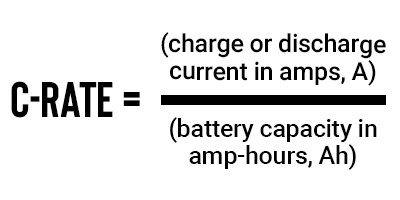What is a battery’s C-rate?
C-rate is one of the most important concepts in understanding drone battery performance. It defines how fast a battery is charged or discharged relative to its capacity — and directly affects flight time, power output, heat and battery lifespan. C-rate is a measure of current (A) relative to the battery’s capacity (Ah). In short, it determines how fast the battery can release stored energy.
Drones demand high bursts of power for takeoff, maneuvering, and maintaining flight — all of which draw high current. C-rate determines whether a battery can safely deliver that current without overheating, voltage sag, cell imbalance or cell damage.
There are a few different types of C-rate. Continuous discharge C-rate refers to the max current the battery can safely deliver continuously until empty. Burst or peak discharge C-rate refers to max current the battery can deliver in short duration – such as one to five seconds. Finally, the charge C-rate is the current used when charging the pack. Typically, the charge C-rate is 1C, but some chemistries exist to support fast charging.
The C-rate is calculated by dividing the battery’s discharge current by its capacity. For example, the Badland Batteries 12S smart battery has a burst current of 255000mA and capacity of 17000mAh. Dividing the burst current by its capacity gives it a burst of 15C. With Badland Batteries’ 17000mAh 12S and 6S batteries, both are rated for 15C burst and 8C continuous.
One thing to keep in consideration is the C-rate is typically defined at the cell level under ideal conditions. Once in a pack and ready for a mission however, those cells are stacked against each other in non-ideal conditions. Because of that, every Badland Batteries pack is de-rated. We take the cell level C-rate and divide by two for our pack level C-rate. This is done for safety and overheating prevention.
What does this all mean for drone performance? A higher C-rate battery can deliver more power, heat less under load, and typically has lower energy density and less energy storage. In short, a drone pilot must consider whether their mission will prioritize short bursts of high power for takeoff and maneuverability or a lower C-rate for longer flight times requiring lower power demands.


